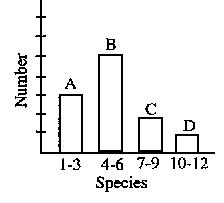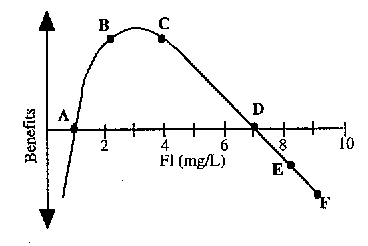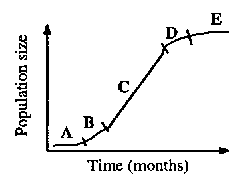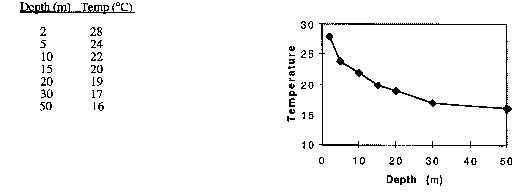Student Content Assessments
Instrument 2: Student Content
Assessment for the Science Cornerstone Project
Project: Science Cornerstone Project:
Institution-Wide Reform of Undergraduate Education in Science,
Mathematics, Engineering and Technology
Portland State University
Funding Source: NSF: Course and Curriculum
Development (DUE)
Purpose: To assess student knowledge of
general physics, biology, chemistry, and earth and space principles
Administered To: Students in the Science
Cornerstone Project
Topics Covered:
- Content Specific Assessment: biology, earth &
space, inquiry concepts, physics
Format/Length: 42 questions total, 1 open-ended
and 41 closed-ended multiple-choice questions
I. Multiple Choice
Please mark only one answer for each question on
the answer sheet provided.
- Biogeochemical cycles include which of the following?
| I. |
nitrogen cycle |
III. |
phosphorous cycle |
| II. |
energy cycle |
IV. |
carbon cycle |
- I and IV only
- II and III only
- III and IV only
- I, II, and IV only
- I don't know
- Most of the solar energy arriving at an ecosystem is
- incorporated into living organisms.
- converted to heat and dissipated.
- destroyed and lost to the system.
- reflected back to the atmosphere and into space.
- I don't know.
- Which of the following apply to natural systems?
- The open systems.
- They are subject to the second law of thermodynamics.
- They require an ongoing input of energy.
- All of the above.
- I don't know.
- Which of the following is true of an ecosystem?
- Some energy cycles back through the system.
- New sources of energy are created when needed.
- Energy is used (destroyed) by a biological community.
- Energy flows unidirectionally through an ecosystem.
- I don't know.
- Given the following diagram of a population X where r
is a constant
 0,
which of the following are true? 0,
which of the following are true?

- Population increase is a function of r.
- Population decrease is a function of r.
- If r is positive, X will exponentially decay.
- If r is zero, X remains constant.
- a, b and c are true.
- b, c, and d are true.
- I don't know.
- An ecosystem is best conceptualized as
- all of the populations in a community.
- all of the organisms in a community.
- a community and its abiotic components.
- all of the species in a community.
- I don't know.
- The primary consumers in terrestrial ecosystems are
- carnivores.
- detritivores.
- omnivores.
- herbivores.
- I don't know.
- An example of positive feedback in an ecosystem might
be
- mountain lion predation on deer populations.
- the effect of red algal (red tide) blooms on intertidal
fish populations.
- the effect of increased grassland production on herbivores.
- the effect of increased temperatures above the lethal
limits for aquatic insects in a small pond.
- I don't know.
- Given a stream channel with the following cross-sectional
dimensions, with the water flowing at velocity, V,
what would the formula for stream flow be?

- V(b + a + c)
- Vb (a + c>
- V(1/2b) (a + c)
- Not enough information provided.
- I don't know.
- Which federal agency has primary responsibility for enforcing
wetland laws?
- US Environmental Protection Agency.
- US Fish and Wildlife Service.
- US Army Corps of Engineers.
- US Wetland Protection Service.
- I don't know.
- Mechanisms for setting regulations of environmental laws
include
- no unreasonable risk.
- risk-benefit balancing.
- cost-benefit balancing.
- standards based on best available technology.
- all of the above.
- I don't know.
- In Oregon, federal waste water discharge permits are granted
by
- US Environmental Protection Agency.
- Oregon Department of Environmental Quality.
- US Army Corps of Engineers.
- US Fish and Wildlife Service.
- I don't know.
- International treaties covers all of the following except
- endangered species protection.
- deep sea mining.
- acid deposition and ozone depletion.
- ocean pollution.
- reducing biodiversity loss.
- I don't know.
- The first step in establishing an environmental policy
is
- securing sufficient funds to develop a public relations
campaign.
- convincing lawmakers that there is a problem.
- developing a cohesive approach to the problem.
- securing support for your position.
- evaluating strategies.
- I don't know.
- Environmental legislation in the United States
- sets standards for pollution.
- encourages resource conservation.
- requires comprehensive evaluation of environmental
impact before an activity is undertaken.
- protects certain ecosystems or species.
- all of the above.
- I don't know.
- Which of the following statements best illustrates the
tragedy of the commons?
- A factory pollutes a river as much as the law allows.
- Pollution can be life threatening above certain levels.
- Some activities harm the environment, but others do
not.
- Irrigated cropland can be ruined by salinization.
- People who walk on the commons ruin the grass.
- I don't know.
- All of the following have been components of federal clean-air
legislation except
- setting ambient air quality standards.
- reducing acid rain in the northeast.
- setting limits on production of greenhouse gases such
as carbon dioxide.
- allowing utilities to buy and sell permits to pollute.
- I don't know.
- The first environmental statute was
- enacted the day after Earth Day.
- the National Environmental Policy Act.
- the Clean Water Act.
- none of the above.
- I don't know.
- The National Environmental Policy Act requires all federal
construction projects with significant impacts
- to obtain the necessary permits.
- to prepare an Environmental Impact Statement before
starting construction.
- to obtain approval of the US Environmental Protection
Agency.
- all of the above.
- none of the above.
- I don't know.
- The purpose of preparing an Environmental Impact Statement
(EIS) is to
- inform the public of a proposed federal action.
- require the selection of the most environmentally
sensitive alternative.
- require the selection of an alternative which avoids
endangered species.
- require the selection of an alternative which avoids
wetlands.
- All of the above.
- None of the above.
- I don't know.
- The adverse effect on the health of people living near
Love Canal in the 1970's led to the enactment of the following?
- Clean Air Act (CAA).
- Clean Water Act (CWA).
- Toxic Substances Control Act (TSCA).
- Comprehensive Environmental Response Compensation
and Liability Act (CERCLA).
- I don't know.
- Which of the following would likely be a discrete variable?
- Distance from stream headwater to mouth.
- Area of a clear cut.
- Frequency of violation of air pollution standard.
- Number of bald eagle eggs in a nest.
- Diameter of Douglas fir at breast height.
- I don't know.
The following histogram describes the frequency of the
fish species richness in a series of samples at a single
site in a stream (questions 23-24)

- In which histogram column would you expect to find the
median value?
- A
- B
- C
- D
- I don't know.
- Give an estimate of the mean.
- 1.5
- 2.75
- 5
- 8
- I don't know.
- Measurements of soil pH from test pits at Brown's Creek,
Oregon were:
- 6.47
6.10
6.17
6.10
6.10
6.16
6.35
These data are reported to how many significant figures?
- 1
- 2
- 3
- 4
- I don't know.
The following graph represents the effects of fluoride
(Fl) on children (questions 26-27)):

- Between which two points is the maximum benefit of fluoride
realized?
- 1-3 mg/L
- 2-4 mg/L
- 5-6 mg/L
- 7-8 mg/L
- 8-10 mg/L
- I don't know.
- Between which points is cost-benefit decreasing?
- A-B
- B-C
- C-D
- D-E
- E-F
- I don't know.
- Assume the total energy available in the first level of
a food web is 10,000 kilocalories/m2.
How many total calories are there in the first level of
a food web in a 100 m2 forest plot?
- 102
- 106
- 109
- 109
- 1012
- I don't know.
This graph shows population growth of flour beetles over
a six month period (questions 29-30):

- Which portion of the graph shows growth at the highest
rate of increase?
- A
- B
- C
- D
- E
- I don't know.
- At segment D growth is
- rapid.
- decelerating.
- accelerating.
- constant.
- I don't know.
- The following are data for nitrate concentration vs. absorbance:
| NO3-N Concentration |
Absorbance |
| 10 mg/L |
0.45 |
| 5 mg/L |
0.21 |
| 1 mg/L |
0.05 |
0 mg/L |
0.00 |
Estimate the NO3-N concentration of a sample
with absorbance = 0.18.
- 4 mg/L
- 3 mg/L
- 9 mg/L
- 2 mg/L
- 7.5 mg/L
- I don't know.
When you take the pH of a water sample with a pH meter
you get a value of 7.45, but the same sample tested with
a color comparison method gives a value of 7.5 (questions
32-33):
- Which data value is more accurate?
- 7.45
- 7.5
- neither.
- cannot be determined.
- both the same.
- I don't know.
- Which data value is more precise?
- 7.45
- 7.5
- neither.
- cannot be determined.
- both the same.
- I don't know.
The following data were collected for the change in
water temperature as a function of depth below the surface
and are plotted below (questions 34-36):

- What would you predict the temperature to be 18 m below
the surface?
- 18oC
- 19oC
- 20oC
- 21oC
- I don't know.
- What would you predict the temperature to be 8 m below
the surface?
- 19oC
- 21oC
- 23oC
- 25oC
- I don't know.
- What would you predict the temperature to be 75 m below
the surface?
- 16oC
- 17oC
- 12oC
- 10oC
- I don't know.
- When copying a topographic map, which of the following
scales can be accurately transferred onto the photocopy
at the time of copying?
- Graphic scale.
- Verbal scale
- Fractional scale.
- All of the above.
- None of the above.
- I don't know.
- The variation between the true North and magnetic North
is always greater than 10o
- True
- False
- I don't know.
- Human activities are affecting the climate by
- increasing greenhouse gas concentration which is probably
warming the atmosphere by trapping heat.
- increasing atmospheric particulate matter which is
probably cooling the atmosphere by increasing albedo.
- neither (a) nor (b).
- both (a) and (b).
- I don't know.
- If average daily streamflow from a watershed is 15 cfs
and average nitrate concentration in the stream is 0.10mg/ft3,
how much total nitrate leaves the system over a 24 hour
period?
- 1.5mg
- 150g
- 130g
- 0.1296mg
- 1.296x105mg
- I don't know.
II. Problem solving
The following question should be answered on the sheet
of paper attached to the multiple choice answer sheet.
1. In accordance with the special
conditions of a Section 404 Wetlands Permit, the Fred Meyer
store in Warrington was required by the US Army Corps of Engineers
to mitigate for the filling of 5.5 acres of non-tidal freshwater
marsh. The original wetland, which was filled, had the following
functional assessment:
| |
LOW |
MODERATE |
HIGH |
| Sediment retention |
|
|
X |
| Water quality improvement |
|
|
X |
| Flood storage |
|
X |
|
| Fisheries habitat |
|
X |
|
| Wildlife habitat |
X |
|
|
| Recreational use |
X |
|
|
The mitigation project constructed by Fred Meyers consisted
of a series of small ponds connected by a swale. The ponds received
water from the parking lot, as well as by direct precipitation.
The water flowed from a catch basin in the parking lot, through
a 200 ft swale to Pond 1, to Pond 2, to Pond 3, and then into
a tidal brackish stream. The ponds were designed to always have
at least 3 ft of water in them and have at least three different
habitats besides open water.
As part of the permit conditions, a five year monitoring
program is required to assess the efficacy of the mitigation
project. You are in charge of this monitoring project.
List the element of a monitoring program including the variables,
the methodology, statistical analysis and report format. Justify
all elements of your design.
|
 |

